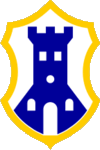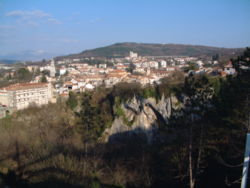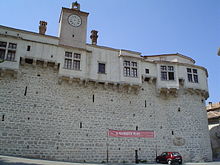- Pazin
-
Pazin — City — City of Pazin
Grad PazinPanorama over Pazin, to the left the Montecuccoli Castle 
Coat of armsLocation of Pazin within Croatia Coordinates: 45°14′N 13°56′E / 45.233°N 13.933°E Country Croatia County Istria Government – Mayor Renato Krulčić (IDS) Area – Total 137 km2 (52.9 sq mi) Population (2001) – Total 9,227 – Density 67/km2 (173.5/sq mi) Time zone CET (UTC+1) – Summer (DST) CEST (UTC+2) Postal code 52 000 Area code(s) 052 Website pazin.hr Pazin (German: Mitterburg, Italian: Pisino) is the administrative seat of Istria County in Croatia. The town has a population of 4,986 (2001), the total Pazin municipality population is 9,227 (2001). In 1991 it was made the capital of the županija for its location in the geographical center of the Istria peninsula and in order to boost the development of its interior territories.
Contents
History
Pazin was first mentioned as Castrum Pisinium in a 983 deed regarding a donation by Emperor Otto II to the Diocese of Poreč.[1] It then belonged to the Imperial March of Istria, which had originally had been under the suzerainty of the newly established Duchy of Carinthia in 976, but separated together with the March of Carniola in 1040.
In the 12th century Mitterburg Castle was in possession of the Lower Carniolan count Meinhard of Schwarzenburg, who held the office of a Vogt of the Poreč bishops (in Latin documents he is known as Cernogradus), and established the Pazin County (earldom). Upon his death, Pazin was inherited by his son-in-law Count Engelbert III of Gorizia (Görz) in 1186.
While most of Istria had gradually been annexed by Venice, Engelbert's descendant Count Albert III of Gorizia in 1374 bequested his Mitterburg estates to the Austrian House of Habsburg, who attached them to their Duchy of Carniola and gave it out in fief to various families, the last of which was the comital House of Montecuccoli[1] from 1766.
Sights
The current town was mostly built beneath the medieval fortress. The present-day Castle Montecuccoli was rebuilt in the 15th and 16th century and disassembled in the 18th and 19th. It has been a museum since the end of World War II.
The Pazin ponor (Pazinska jama/Foiba) located under the castle was partially explored by Édouard-Alfred Martel in 1896 and is the best example of karst hydrography and morphology in Istria. Castle and a gorge inspired Jules Verne for the novel Mathias Sandorf of 1885.
Settlements
The following settlements comprise the city's administrative region:[2]
- Beram
- Bertoši
- Brajkovići
- Butoniga
- Grdoselo
- Heki
- Ježenj
- Kašćerga
- Kršikla
- Lindar
- Lovrin
- Pazin
- Trviž
- Vela Traba
- Zabrežani
- Zamask
- Zamaski Dol
- Zarečje
Famous people born in Pazin/Pisino
- Juraj Dobrila (1812-1882) - bishop of Istria
- Tugomil Ujčić (1906-?), educator and writer
- Luigi Dallapiccola (1904–1975), composer
- Pier Antonio Quarantotti Gambini (1910–1965), poet and writer [1]
- Antun Motika (1902–1992) - photographer
References
- ^ a b Naklada Naprijed, The Croatian Adriatic Tourist Guide, pg. 27, Zagreb (1999), ISBN 953-178-097-8
- ^ http://www.dzs.hr/hrv/censuses/census2001/Popis/H01_01_03/h01_01_03_zup18-3212.html
External links
Subdivisions of Istria County Cities and towns Municipalities Bale · Barban · Brtonigla · Cerovlje · Fažana · Funtana · Gračišće · Grožnjan · Kanfanar · Karojba · Kaštelir-Labinci · Kršan · Lanišće · Ližnjan · Lupoglav · Marčana · Medulin · Motovun · Oprtalj · Pićan · Raša · Sveti Lovreč · Sveta Nedelja · Sveti Petar u Šumi · Svetvinčenat · Tar-Vabriga · Tinjan · Višnjan · Vižinada · Vrsar · ŽminjCategories:- Populated places in Istria County
- Cities and towns in Croatia
Wikimedia Foundation. 2010.




